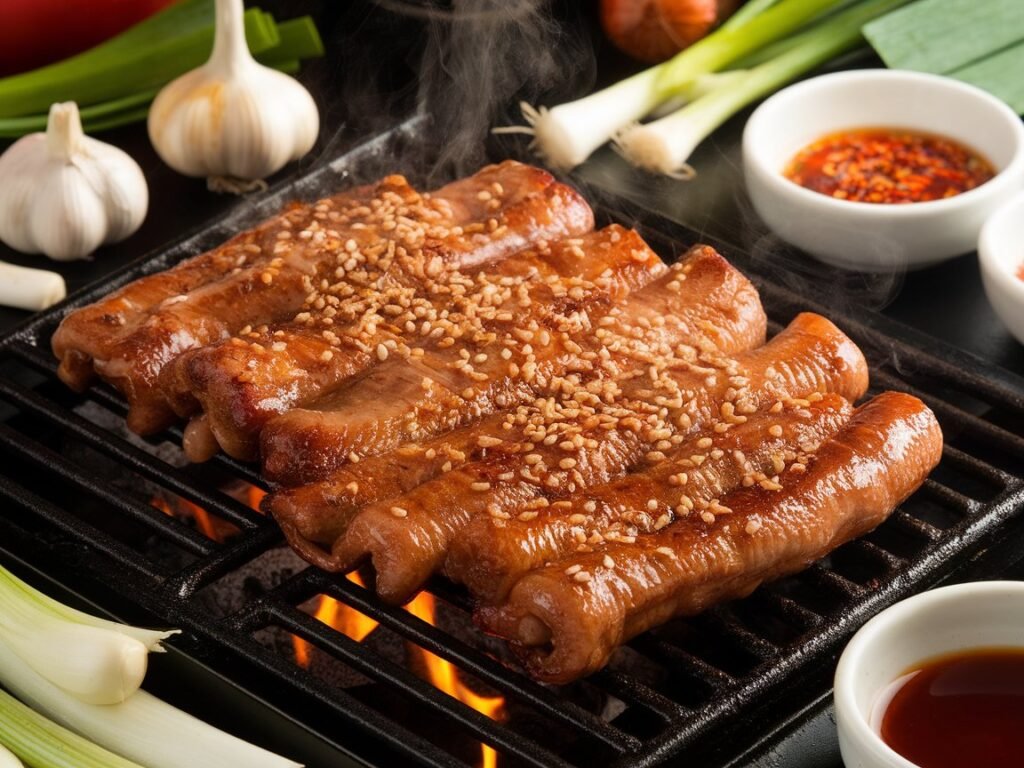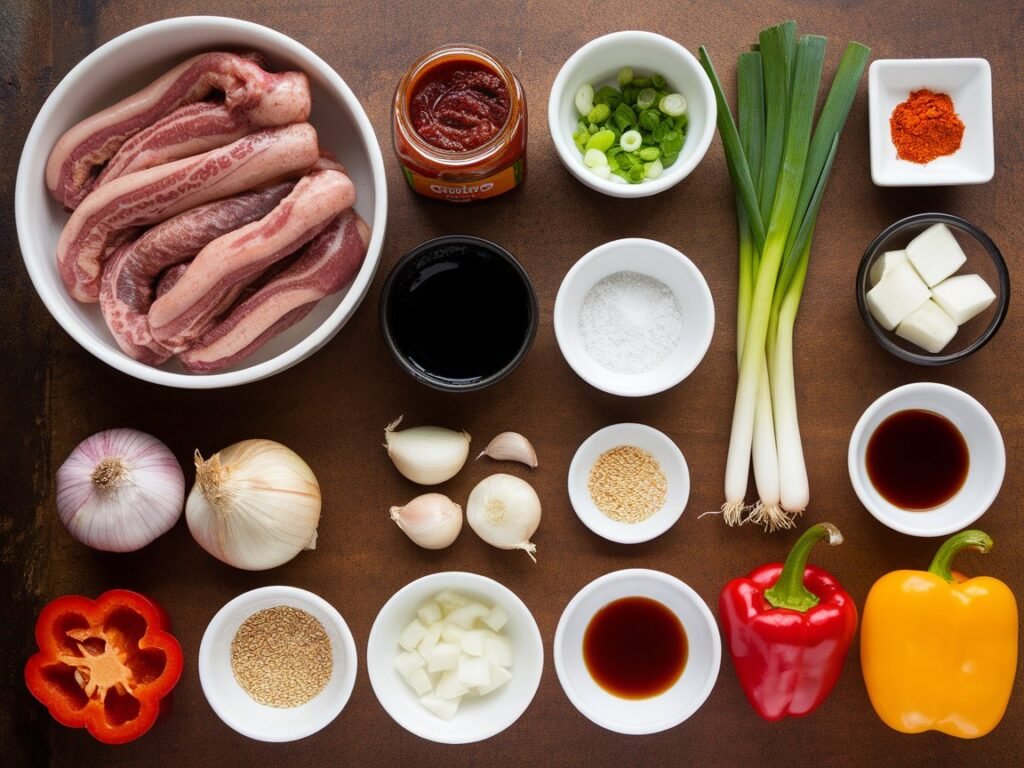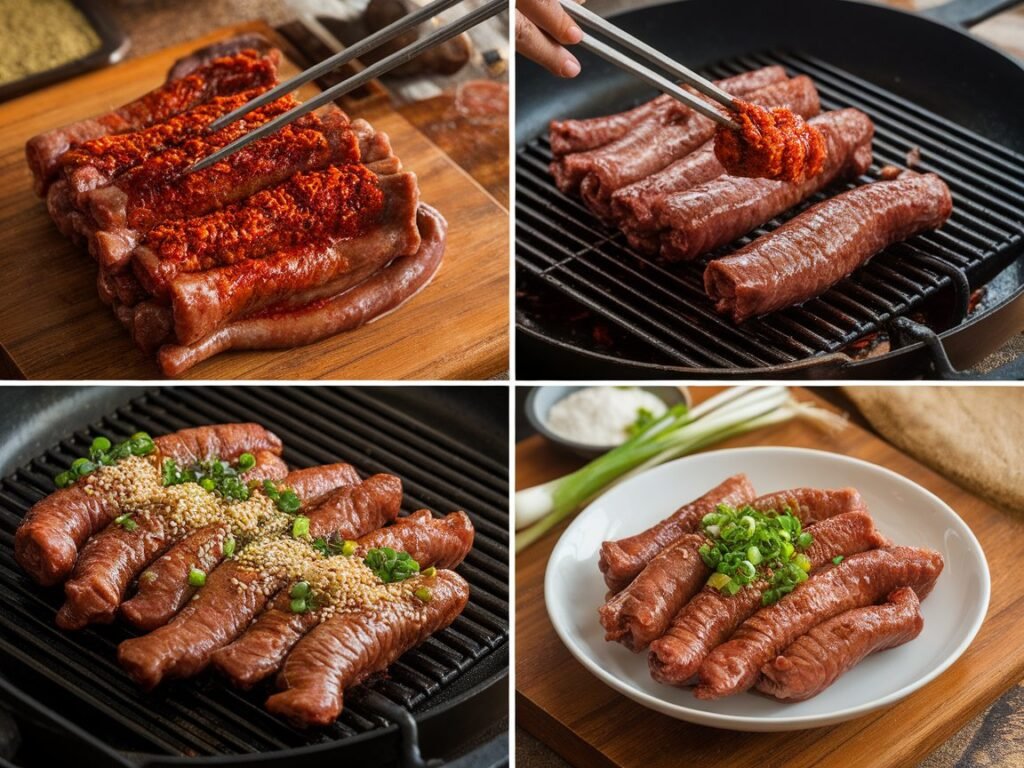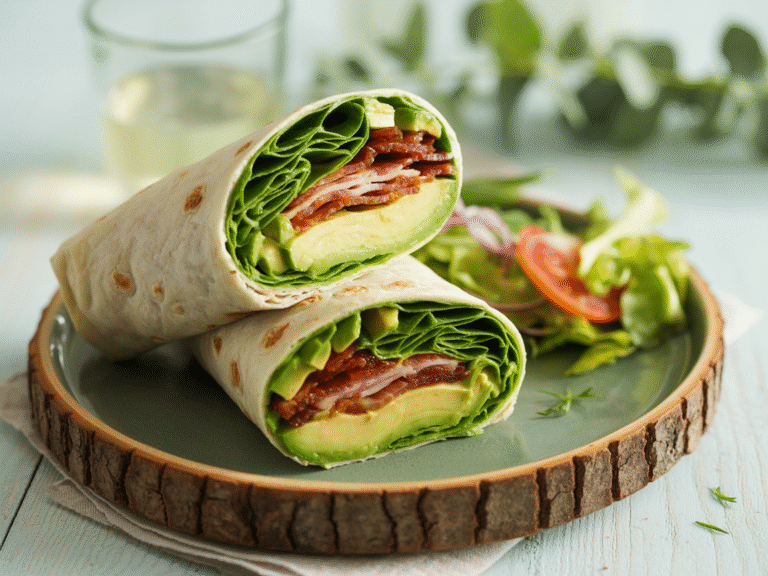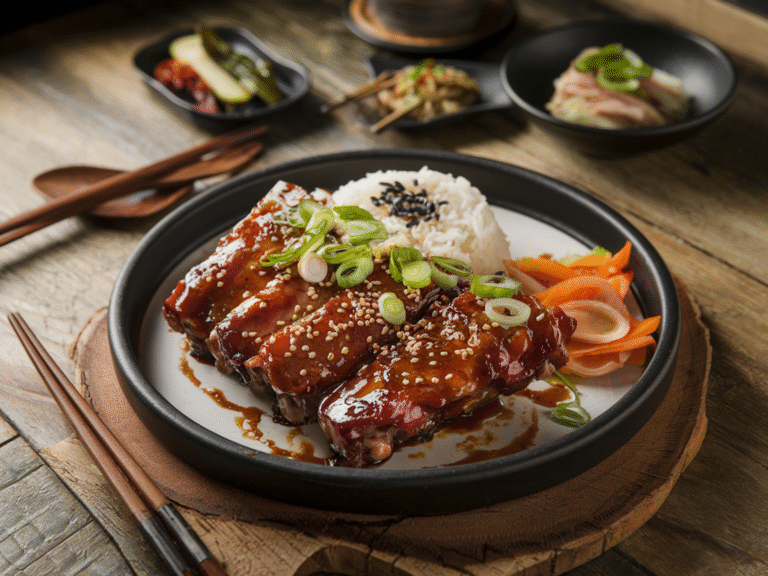Gobchang Gui Recipe | Korean Grilled Beef Intestines with Spicy Marinade
Gobchang Gui Recipe: Korean Grilled Beef Intestines with Spicy Marinade
1. Introduction
If you’ve ever dined at a Korean BBQ restaurant, you’ve likely encountered the unique, flavorful experience of Gobchang Gui. This Korean dish features beef intestines (known as gobchang) that are marinated, grilled, and served with fresh vegetables and savory dipping sauces. While it might sound unconventional to some, Gobchang Gui is an absolutely delicious dish that has a rich, smoky flavor that will leave your taste buds craving more.
Why You’ll Love This Recipe
Gobchang Gui isn’t just about the beef intestines – it’s about the experience. Grilling the beef intestines creates a crispy, caramelized texture on the outside while keeping them tender and juicy on the inside. The marinade, made from gochujang (Korean chili paste), soy sauce, sesame oil, and garlic, provides a perfect balance of heat, umami, and richness that pairs beautifully with grilled vegetables and fresh greens.
In this recipe, you’ll learn everything you need to know about making Gobchang Gui from start to finish. From the marinade to the grilling techniques, I’ll guide you through each step to ensure that you can recreate this Korean BBQ classic right in your own kitchen. Plus, I’ll share tips for customizing the dish and making it your own!
2. Ingredients Breakdown
Before diving into the cooking process, let’s break down the key ingredients that make Gobchang Gui so special:
- Beef Intestines (Gobchang, 500g):
Beef intestines are the main ingredient in Gobchang Gui. When prepared properly, they offer a unique texture that’s both chewy and tender. You’ll want to ensure that the intestines are cleaned thoroughly before cooking. If you’re new to working with gobchang, you can ask your butcher to clean and prep them for you. They should be cut into smaller pieces (about 2-3 inches long) for easy grilling. - Gochujang (3 tbsp):
Gochujang is a Korean fermented chili paste that’s slightly sweet, tangy, and spicy. It’s a staple in Korean cuisine and brings a depth of flavor to the marinade. If you want a milder version, you can reduce the amount of gochujang or substitute it with a milder chili paste. - Soy Sauce (2 tbsp):
Soy sauce adds saltiness and umami to the marinade, helping to balance out the heat from the gochujang. You can use regular soy sauce or tamari for a gluten-free version. - Sesame Oil (1 tsp):
Sesame oil is key for bringing a nutty, aromatic flavor to the marinade. It’s commonly used in Korean cooking to enhance the richness of the dish. - Garlic (4 cloves, minced):
Fresh garlic adds an extra layer of flavor and complexity to the dish. It pairs beautifully with the gochujang and adds an irresistible aroma. - Green Onions (2 stalks, chopped):
Green onions are used both in the marinade and as a garnish. They add a crisp, fresh flavor that balances the richness of the grilled beef intestines. - Sesame Seeds (1 tsp, optional):
Toasted sesame seeds make a perfect garnish, adding a crunchy texture and a nutty flavor to the finished dish. - Vegetables (optional):
Onions, bell peppers, or zucchini can be added to the grill alongside the intestines. They add color and texture to the dish and pair wonderfully with the savory beef intestines.
Substitutions and Dietary Preferences:
- Gluten-Free: Use tamari instead of soy sauce to make the dish gluten-free.
- Vegetarian Option: Replace the beef intestines with tofu or tempeh. You can still use the same marinade for these alternatives.
- Milder Version: If you prefer less spice, you can use a combination of gochujang and a mild chili paste, or even swap the gochujang for sweet chili sauce for a less fiery version.
3. Step-by-Step Instructions
Now that we’ve got all the ingredients ready, let’s dive into the process of making Gobchang Gui!
- Clean the Beef Intestines:
If your beef intestines aren’t pre-cleaned, start by rinsing them thoroughly under cold water. Remove any excess fat and debris, then cut them into 2-3 inch pieces. For an easier prep, you can ask your butcher to clean and prepare them for you. - Prepare the Marinade:
In a bowl, combine 3 tbsp of gochujang, 2 tbsp of soy sauce, 1 tsp of sesame oil, minced garlic, and any additional spices you like. Stir well until you have a smooth, thick marinade. Taste and adjust the spice level by adding more gochujang or sweetener if necessary. - Marinate the Beef Intestines:
Add the cleaned beef intestines to the marinade and toss them to coat evenly. Let them marinate for at least 30 minutes, but ideally, marinate them for 2-3 hours to allow the flavors to fully develop. - Preheat the Grill or Skillet:
Heat your grill or grill pan over medium-high heat. If you don’t have a grill, a cast iron skillet or grill pan will work just as well. - Grill the Beef Intestines:
Place the marinated beef intestines on the grill or in the skillet. Grill for 5-7 minutes per side, turning occasionally until the intestines are crispy on the outside and cooked through on the inside. Be careful not to overcook them, as they can become tough. - Add the Vegetables:
While the intestines are grilling, you can also grill the vegetables, such as onions, bell peppers, or zucchini, until they’re slightly charred and tender. - Serve and Garnish:
Once the beef intestines are grilled to perfection, remove them from the heat. Garnish with chopped green onions and toasted sesame seeds. Serve immediately with steamed rice and kimchi for an authentic Korean meal.
4. Tips and Variations
- Grilling Tips: For an extra crispy texture, grill the intestines on high heat for a few minutes on each side. Just be careful not to burn them.
- Spicy Version: Adjust the level of spice by adding more gochujang or chili flakes to the marinade.
- Vegetable Options: You can add any vegetable of your choice to the grill. Bell peppers, zucchini, and mushrooms work great.
Variations:
- Gluten-Free: Use tamari or coconut aminos in place of soy sauce for a gluten-free version.
- Vegan/Vegetarian Option: Replace the beef intestines with tofu or tempeh for a plant-based alternative.
5. Serving Suggestions
Gobchang Gui is best enjoyed with a variety of sides and accompaniments:
- Sides: Serve with steamed rice, kimchi, and pickled vegetables for a well-rounded meal.
- Breads: Enjoy with Korean pancakes (jeon) or a side of naan for extra comfort.
- Pairings: Pair with soju or Korean beer for the ultimate Korean BBQ experience. For a non-alcoholic drink, try green tea or sparkling water.
6. Storage and Reheating Instructions
- In the Fridge: Store any leftover Gobchang Gui in an airtight container for up to 3 days.
- In the Freezer: You can freeze leftover grilled beef intestines for up to 2 months. Just make sure to let them cool before freezing in a sealed container.
Reheating Instructions:
- Microwave: Reheat the leftovers in the microwave for 1-2 minutes, stirring halfway through.
- Stovetop: Reheat on a skillet over low heat for 5-7 minutes, adding a little water or soy sauce to restore moisture.
7. Recipe Notes
- Can Be Prepped Ahead of Time: Marinate the beef intestines ahead of time to enhance the flavor. Marinate for up to 24 hours in the refrigerator.
- Best with Fresh Ingredients: For the best texture and flavor, use fresh, high-quality beef intestines.
- Use a Grill Pan or Outdoor Grill: For the most authentic grilling experience, use a grill pan or outdoor BBQ to achieve that perfect smoky flavor.
8. Nutrition Information (Per Serving)
| Nutrient | Amount per Serving |
|---|---|
| Calories | 260 |
| Fat | 18g |
| Saturated Fat | 6g |
| Carbs | 10g |
| Sugar | 3g |
| Fiber | 2g |
| Protein | 20g |
| Sodium | 800mg |
| Cholesterol | 70mg |
| Calcium | 50mg |
| Iron | 3mg |
Nutrition information is an estimate and may vary based on specific ingredients used.
9. Recipe Card Summary
- Course: Main
- Cuisine: Korean
- Servings: 4
- Prep Time: 20 minutes
- Cook Time: 20 minutes
- Total Time: 40 minutes
Ingredients:
- 500g beef intestines (gobchang), cleaned and cut
- 3 tbsp gochujang
- 2 tbsp soy sauce
- 1 tsp sesame oil
- 4 cloves garlic, minced
- 1 tsp grated ginger
- 1 tbsp sugar
- 1 medium carrot, sliced
- 2 cups cabbage, chopped
- 2 stalks green onions, chopped
- 1 tsp sesame seeds (optional)
Instructions:
- Prepare and clean the beef intestines.
- Mix marinade and marinate intestines for at least 30 minutes.
- Preheat grill or skillet.
- Grill beef intestines for 5-7 minutes on each side.
- Grill vegetables and serve with garnishes.
Notes: Marinate for longer for better flavor.
10. Health Benefits
- Beef Intestines: High in protein and iron, beef intestines provide a good source of essential nutrients.
- Gochujang: Contains capsaicin, which can boost metabolism and reduce inflammation.
- Garlic: Known for its health benefits, garlic supports heart health and has antimicrobial properties.
11. Suggested Sauce
Pair with ssamjang (a Korean dipping sauce made from gochujang, soy sauce, and sesame oil) for extra flavor, or drizzle with sesame oil for a more subtle finish.
12. Avoid These Mistakes
- Don’t Overcrowd the Grill: Cook in batches if necessary to avoid steaming the intestines.
- Ensure Even Grilling: Rotate the intestines for an even, crispy texture.
- Marinate Long Enough: Let the intestines marinate for at least 30 minutes, or up to 24 hours, for maximum flavor.
13. FAQs
- Can I use chicken for this recipe instead of beef intestines?
Yes, chicken thighs or breasts can be substituted, though the texture will differ. - How do I clean beef intestines?
If they aren’t pre-cleaned, rinse thoroughly and scrape out any fat or debris. You can also ask your butcher to clean them for you. - Can I use a stovetop pan instead of a grill?
Yes, a cast iron skillet or grill pan works just as well for grilling the intestines. - What’s a good side dish to serve with Gobchang Gui?
Serve with kimchi, steamed rice, or a fresh cucumber salad for a complete meal. - Can I freeze leftovers?
Yes, you can freeze the leftovers for up to 2 months. - How do I make the marinade less spicy?
Use less gochujang or mix it with ketchup for a milder flavor.
14. Final Thoughts
Gobchang Gui is a delicious and exciting Korean dish that’s sure to impress your family and friends. The unique flavors, combined with the grilling process, make it a standout meal that’s perfect for any occasion. Whether you’re hosting a BBQ or looking for something new to try, this recipe will bring a taste of Korean street food right into your home. Let me know how it turns out for you in the comments below!

